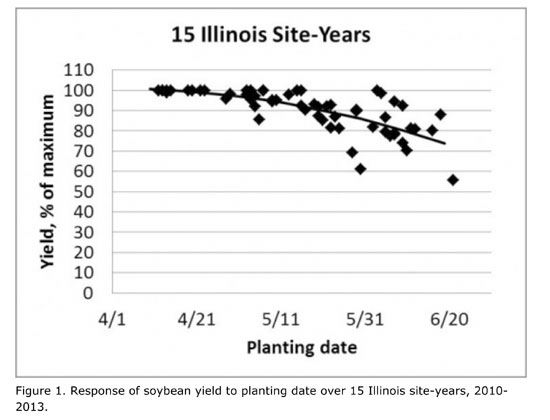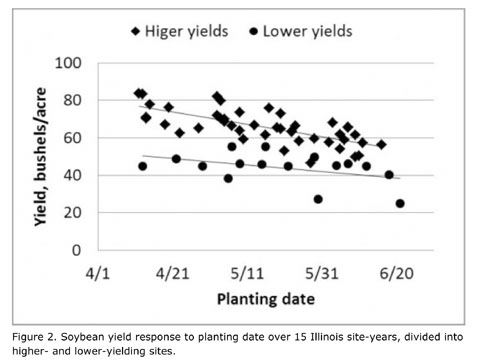Another Look At Soybean Planting Date
URBANA, ILL.
Soybean planting is off to a mediocre start in Illinois, with 26
percent of the crop planted by May 11, and limited progress with the
rain of this past week. Planting will resume in some places this week,
but other areas remain wet and it will take some time for soils to dry
out. In comparison with recent history this is not yet a serious delay,
but as time passes the delay will become a bigger concern.
Over the past four years we have conducted studies that, among other
things, have compared yields of soybeans planted over a range of dates,
from mid-or late April (or when conditions allow) into early to
mid-June. This research was funded by the Illinois Soybean Association.
We were unable to produce useful data from most southern Illinois
sites due to the late start in many cases, and poor stands in others.
This demonstrates little other than that late starts are quite common in
southern Illinois, and that poor stands are not more common from early
planting than from late planting. Instead, poor stands almost always
result from heavy rainfall soon after planting, regardless of when the
crop is planted.
I combined data from 15 site-years (not including Perry in 2012,
where yields were every low) in central and northern Illinois, with
yields at each site-year calculated as percent of the maximum yield for
that trial. Figure 1 shows the overall response to planting dates over
these sites. The average maximum yield across all trials was 66.2
bushels per acre, so each percentage point is about 3/2rds of a bushel.
Based on these numbers, a delay to May 20 means yields on average
about 10% less than maximum. From May 20 to the end of May, the drop is
about 0.5 percent per day of delay. From June 1 to 10, it is about 0.6
percent per day. The cumulative loss by June 10 is about 20 percent.
While Figure 1 shows the best prediction we have for planting date in
Illinois, the curve doesn’t tell the whole story. When we look at yield
data from separate trials, we find that there seem to be two lines –
one for trials where yields are high and one for trials where yields are
lower (Figure 2).


Because we typically don’t know what yield level will be, data
presented as in Figure 2 don’t provide a better prediction of yield loss
than Figure 1. Rather, they simply show that when something other than
planting date limits yield, planting date becomes less important as a
factor that influences yield.
As I said about corn planting date in an earlier article, having
planting delayed by wet weather past a certain date – May 15 or 20 for
soybeans – does not rule out getting high yields. But we still want to
plant as soon as we can in order to have plants take better advantage of
growing conditions that should continue to improve starting soon. ∆
DR. EMERSON NAFZIGER: Research Education Center Coordinator, Professor, University of Illinois